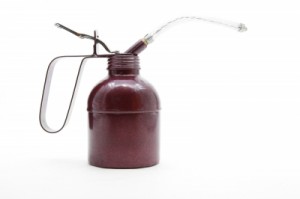Home > Press > Lubricating with Nanometer-Sized Silver
 |
| Image: Workshop and DIY / FreeDigitalPhotos.net |
Abstract:
The ever-increasing demands for energy efficiency and high temperature operation of machines require a careful consideration of lubricants for optimal performance. Tribological components like bearings and gears have driven the continual sophistication of lubricating materials and the development of additives which enhance their performance.
Lubricating with Nanometer-Sized Silver
Germany | Posted on March 22nd, 2012These additives are designed to enhance specific attributes of lubricant properties, such as viscosity, performance at particular temperatures, friction and wear reduction, rust and corrosion prevention, or oxidative stability. Conventional oils and greases undergo severe degradation at elevated temperatures, whereas solid lubricants can function at far higher temperatures.
Commonly, graphite and MoS2, which have been studied for decades, are used as lubricant additives, but nanometer-sized particles have more recently made an appearance. Nanoparticles are particularly effective because they form more stable dispersions in oils than do larger particles.
To get an efficient and cost-effective system, Christina P. Twist and co-workers from the Northwestern University in Evanston, Illinois (USA), and the University of Jordan in Amman (Jordan) synthesized two silver complexes and added them to engine oil at various concentrations. Silver is a relatively soft metal and has been previously investigated as a solid lubricant in the form of coatings.
The researchers report on the thermolytic and tribological properties of these complexes as they are transformed to lubricious silver metal. They evaluated the performance of these complexes as lubricant additives via pin-on-disk friction tests and wear scar measurements.
Results of the friction tests and wear measurements indicate a significant reduction in wear and little change in friction. The improved wear performance is attributed to the thermolysis and deposition of the silver-based complexes in the wear scar. However, while the oil and silver complex suspensions were mixed thoroughly before testing for at least 15 min to achieve as homogeneous distribution as possible, some larger crystallites were likely present. This problem can be remedied in future using more lipophilic ligands.
####
For more information, please click here
Copyright © Wiley-VCH Materials Science Journals
If you have a comment, please Contact us.Issuers of news releases, not 7th Wave, Inc. or Nanotechnology Now, are solely responsible for the accuracy of the content.
| Related News Press |
News and information
![]() Researchers develop molecular qubits that communicate at telecom frequencies October 3rd, 2025
Researchers develop molecular qubits that communicate at telecom frequencies October 3rd, 2025
![]() Next-generation quantum communication October 3rd, 2025
Next-generation quantum communication October 3rd, 2025
![]() "Nanoreactor" cage uses visible light for catalytic and ultra-selective cross-cycloadditions October 3rd, 2025
"Nanoreactor" cage uses visible light for catalytic and ultra-selective cross-cycloadditions October 3rd, 2025
Discoveries
![]() Researchers develop molecular qubits that communicate at telecom frequencies October 3rd, 2025
Researchers develop molecular qubits that communicate at telecom frequencies October 3rd, 2025
![]() Next-generation quantum communication October 3rd, 2025
Next-generation quantum communication October 3rd, 2025
![]() "Nanoreactor" cage uses visible light for catalytic and ultra-selective cross-cycloadditions October 3rd, 2025
"Nanoreactor" cage uses visible light for catalytic and ultra-selective cross-cycloadditions October 3rd, 2025
Materials/Metamaterials/Magnetoresistance
![]() First real-time observation of two-dimensional melting process: Researchers at Mainz University unveil new insights into magnetic vortex structures August 8th, 2025
First real-time observation of two-dimensional melting process: Researchers at Mainz University unveil new insights into magnetic vortex structures August 8th, 2025
![]() Researchers unveil a groundbreaking clay-based solution to capture carbon dioxide and combat climate change June 6th, 2025
Researchers unveil a groundbreaking clay-based solution to capture carbon dioxide and combat climate change June 6th, 2025
![]() A 1960s idea inspires NBI researchers to study hitherto inaccessible quantum states June 6th, 2025
A 1960s idea inspires NBI researchers to study hitherto inaccessible quantum states June 6th, 2025
![]() Institute for Nanoscience hosts annual proposal planning meeting May 16th, 2025
Institute for Nanoscience hosts annual proposal planning meeting May 16th, 2025
Announcements
![]() Rice membrane extracts lithium from brines with greater speed, less waste October 3rd, 2025
Rice membrane extracts lithium from brines with greater speed, less waste October 3rd, 2025
![]() Researchers develop molecular qubits that communicate at telecom frequencies October 3rd, 2025
Researchers develop molecular qubits that communicate at telecom frequencies October 3rd, 2025
![]() Next-generation quantum communication October 3rd, 2025
Next-generation quantum communication October 3rd, 2025
![]() "Nanoreactor" cage uses visible light for catalytic and ultra-selective cross-cycloadditions October 3rd, 2025
"Nanoreactor" cage uses visible light for catalytic and ultra-selective cross-cycloadditions October 3rd, 2025
Industrial
![]() Quantum interference in molecule-surface collisions February 28th, 2025
Quantum interference in molecule-surface collisions February 28th, 2025
![]() Boron nitride nanotube fibers get real: Rice lab creates first heat-tolerant, stable fibers from wet-spinning process June 24th, 2022
Boron nitride nanotube fibers get real: Rice lab creates first heat-tolerant, stable fibers from wet-spinning process June 24th, 2022
![]() Nanotubes: a promising solution for advanced rubber cables with 60% less conductive filler June 1st, 2022
Nanotubes: a promising solution for advanced rubber cables with 60% less conductive filler June 1st, 2022
|
|
||
|
|
||
| The latest news from around the world, FREE | ||
|
|
||
|
|
||
| Premium Products | ||
|
|
||
|
Only the news you want to read!
Learn More |
||
|
|
||
|
Full-service, expert consulting
Learn More |
||
|
|
||








